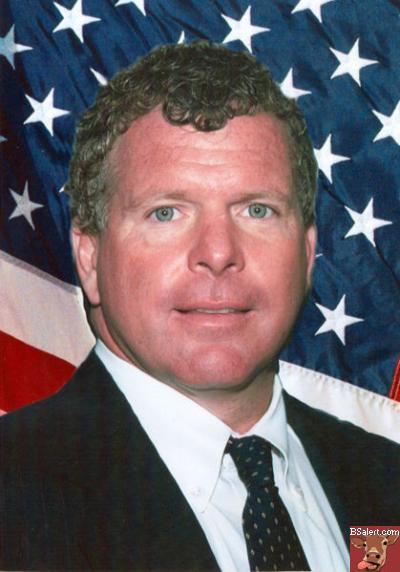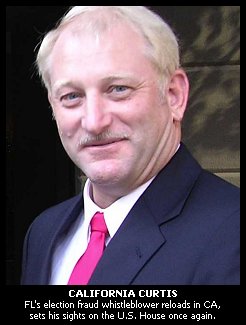Revisiting the 2004 election in Florida
Following up previous posts—
The affidavit by computer programmer Clinton Curtis, written about previously, refers to the unexpected death of Raymond C. Lemme. After Curtis left Yang Enterprises (YEI), he went to work for the Florida Department of Transportation. There he found instances of over-billing by Yang Enterprises, a state contractor.

Curtis
Curtis discussed Yang several times with Lemme, an IG investigator for the DOT. Soon afterward, Mr. Lemme was found dead in a motel room in Valdosta, Ga., death reported initially as a suicide. He died July 1, 2003. Lemme was 56, in good health, and had no known ties in Valdosta. Lemme’s supervisor at the Florida DOT, Robert (Bob) Clift, said in telephone interviews that “So far as I know, only Ray Lemme knows what he was doing in Valdosta, Georgia.”
The question remains, what was Lemme doing in Valdosta? July 1 was the Tuesday before the Fourth; was he on vacation? Was he on a work assignment? Calling in response to questions by voice mail, Clift said, “Neither.” Clift added, “As you know from the police reports, his wife and children are in Tallahassee, so he wasn’t on vacation or anything. And he certainly wasn’t on a work assignment.” In answer to a further question, he says also, “No, he wasn’t on leave.”
At the time of the interviews, Clift himself supported the hypothesis that Lemme’s death was suicide. He declined to speculate on motives, saying the family had been through enough. Clift said emphatically, however, that the death was not related to Lemme’s job performance, which he called “stellar.”
This assessment is borne out by a house organ of the transportation department. The Aug. 2003, Perspectives on Excellence, a Florida DOT newsletter, features an award won by the Inspector General’s Contract Fraud Investigation Team. Lemme was on the team.
A team photograph is followed by paragraphs of praise:
“The Inspector General’s office executed Florida government’s most successful attack on vendor contract fraud, producing 15 criminal convictions and recovering $1.5 million. This team is responsible for placing 83% of individual and company names on the Department of Management Services’ list of convicted vendors who are no longer eligible to compete for state business.
Governor Bush’s Inspector General recently presented this accomplishment as a best practice, at a national conference of Inspectors General.”
One of the vendors “no longer eligible to compete for state business” was Curtis’s former employer and Rep. Tom Feeney’s former client, Yang Enterprises. Curtis alleges in his affidavit that the vote-tampering software developed at Yang was a project initiated by Feeney. Feeney, who also served in the Florida state house and had been Jeb Bush’s running mate for lieutenant governor in 1994, went on to Congress in 2002.

Feeney
Lemme’s supervisor confirmed that Lemme was part of an award-winning team and reiterates that his work was excellent. “I worked with him probably for about 18 months to two years,” Clift said, and Lemme was “an outstanding performer, one of the most thorough investigators that I’ve ever worked with.”
“Everyone here who worked with him would say the same thing; we would all say that.”
Clift also emphasized that “All of us who worked with him support the conclusions of the Valdosta, Georgia, police,” that the death was a suicide. Calling suspicions about the surprising death “unfortunate,” Clift also repeated emphatically that Lemme’s “assignment had absolutely nothing to do with voting machines.” “It was not anything secret.” The IG unit investigates “employee misconduct and contract frauds as they impact DOT,” Clift explained, giving as examples employees claiming more time than actually put in, or travel claimed that is not supported, etc. “On the contractor perspective, [we investigate] contractors who billed us for work they did not do.”
Clift clarified emphatically that Lemme’s job was not in jeopardy. Asked whether Lemme had been fired or going to be fired, Clift said, “Absolutely not. I was his supervisor. His job performance was stellar; other people under him and around him looked up to Ray and modeled their performance on his.” It was Clift who nominated the contract fraud investigation team for a job award. Whatever the cause of death, it was not related to Lemme’s job performance.
But in Clift’s opinion, “this voting machine stuff doesn’t square with the cause of death either.” He reiterated that the cloud of suspicion was “unfortunate.” Responding to further questions, Clift said he had read Clinton Curtis’s affidavit. He confirmed that Curtis reported Yang’s over-billing to the Florida DOT. Without going into specifics, he also confirmed what Curtis said. “Every investigation has varying degrees” of accuracy in its leads, Clift said in general terms, with some facts or details more solid than others. Referring to public record, he also confirmed that Yang Enterprises “doesn’t hold the contract any more.”
Clift filed an affidavit with Florida police about Lemme June 30, 2003. Clift told police, in part,
“I arrived at my office this morning at about 6:30 a.m. My message light was blinking. I had a message from Ray which was left at 6:20 a.m. He said “Something’s come up. I’ll be in late. I’ll call you later I knew Ray had a appointment at the FDOT General Counsel’s office at 1:30. I was called about 2:00 by the attorney he was to meet—he didn’t show up. This is very out of character for Ray . . .”
Strange timing
The unexpectedness of Lemme’s death, Lemme’s unexplained presence in Valdosta, Ga., and the timing of the death in the context of Florida’s nefarious electoral politics raised questions that were never answered. As written previously, Clinton Curtis’s sworn statement alleges that software company Yang Enterprises had developed a prototype for vote fraud. The project was developed, the affidavit states, at the specific request of Rep. Tom Feeney (R- Fla.). Before running for Congress Feeney was lobbyist and counsel for Yang. The strangeness of Mr. Lemme’s death, like Curtis’s affidavit, was not considered a news topic by larger corporate media outlets—intensifying suspicions that the death might be foul play, and might be connected to events at Yang. A more normal reaction in the press would at least have reported allegations in the affidavit.
One lengthy account of the matter is given here, with graphic photographs included. Setting aside any hypothetical China connection, from the perspective of several years afterward it still looks as though the crime should have received greater, sober attention than it got.




